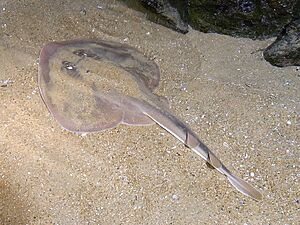Fanray facts for kids
Quick facts for kids Fanray |
|
|---|---|
 |
|
| Adult specimen | |
| Conservation status | |
| Scientific classification | |
| Genus: |
Platyrhina
|
| Species: |
sinensis
|
| Synonyms | |
|
Platyrhina limboonkengi Tang, 1933 |
|
The fanray (Platyrhina sinensis) is a type of ray that lives in the western Pacific Ocean. It's known for its flat, fan-shaped body. These rays usually grow to be about 30 to 50 centimeters (12 to 20 inches) long and weigh between 200 to 500 grams (7 to 18 ounces). Fanrays have a brown top and a white bottom. They mostly eat small fish and crustaceans, like shrimp. They don't move very fast and spend a lot of time on the seafloor.
Male fanrays can live up to five years, while females can live up to twelve years. Both sexes become adults and can have babies when they are between two and five years old. You can find fanrays in countries like China, Japan, Taiwan, Korea, and Vietnam. They live in shallow ocean waters, usually less than 100 meters (330 feet) deep. Sadly, the number of fanrays might be going down because they are often caught by accident when people are fishing for other things.
Contents
What Does a Fanray Look Like?
Fanrays can grow up to 68 centimeters (27 inches) long, but most are between 30 and 50 centimeters (12 to 20 inches) long. They usually weigh from 200 to 500 grams (7 to 18 ounces). Their body is very flat and shaped like a fan.
The top of a fanray is brown, and its underside is white. The edges of its body are yellowish. They have wide nostrils and small eyes. Their snout, which is like a nose, is short. Their mouth has a line across it that splits it. Fanrays have many small teeth and pointy, thorn-like scales on their upper body.
Fanray Behavior and Life Cycle
Fanrays eat small fish and crustaceans, especially shrimp and tiny, shrimp-like creatures called mysids. They usually wait on the sea floor for food to come by. Fanrays are active at night, which means they are nocturnal.
These rays lay eggs, which is called oviparity. They usually mate in April or May. Fanrays are slow swimmers because they can only move by wiggling their tail back and forth.
How Fanrays Grow
Male fanrays live for about five years. They become mature, meaning they can reproduce, when they are two to four years old. Female fanrays live longer, up to twelve years. They become mature when they are three to five years old. Both males and females are ready to reproduce when they are about 35 to 40 centimeters (14 to 16 inches) long. Females tend to be a little bigger than males when they mature.
Studies have shown that female fanrays grow slower than males. However, adult females end up being larger overall. Compared to other similar ray species, fanrays grow and mature quickly, but they don't live for a very long time.
Where Fanrays Live
Fanrays live in the western part of the Pacific Ocean. They prefer coastal areas with sandy sea floors. You can usually find them in waters between 30 and 40 meters (98 to 130 feet) deep, but they can live in waters up to 100 meters (330 feet) deep.
They are found off the coasts of China, Japan, Taiwan, Korea, and Vietnam. It's also possible they live near Indonesia. Fanrays are very common in places like Ariake Bay in Japan, and also in the Yellow Sea and Bohai Sea.
Fanrays and Fishing
Fanrays are often caught by accident in fishing nets, especially in gillnets and trawls. This accidental catch is called bycatch. Sometimes, these fanrays are thrown back into the ocean, but other times they are kept and used. People can eat their meat fresh or dried.
We don't know exactly how many fanrays there are, or if their numbers are going up or down in all areas. However, we do know that their population in the East China Sea is decreasing because of fishing activities. Since fanrays live in shallower waters, it's easier for fishing boats to catch them.
Currently, there are no special rules or efforts to protect fanrays. Because their population is likely declining, the IUCN Red List has listed the fanray as an endangered species. This means they are at a high risk of becoming extinct in the wild.


